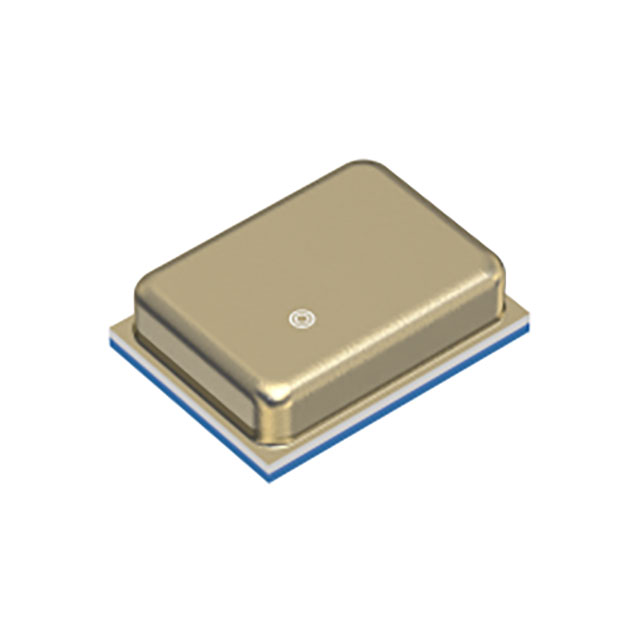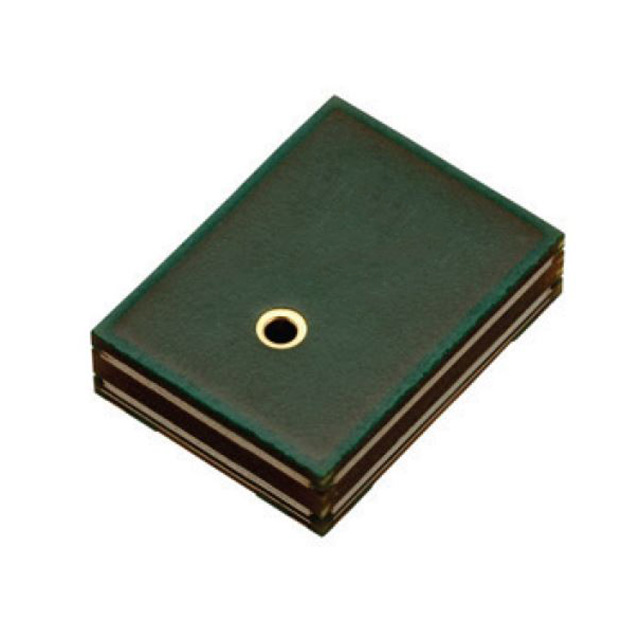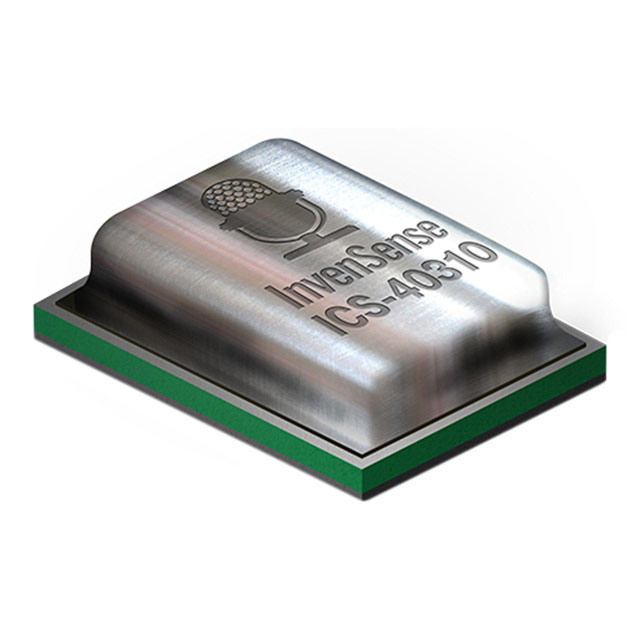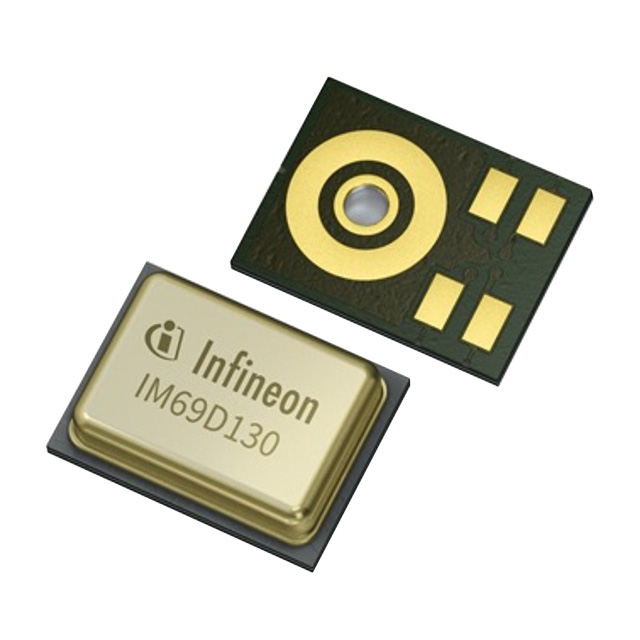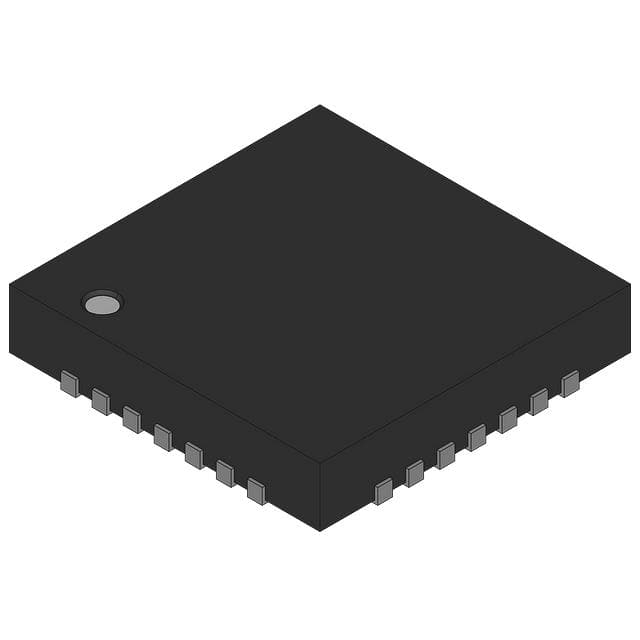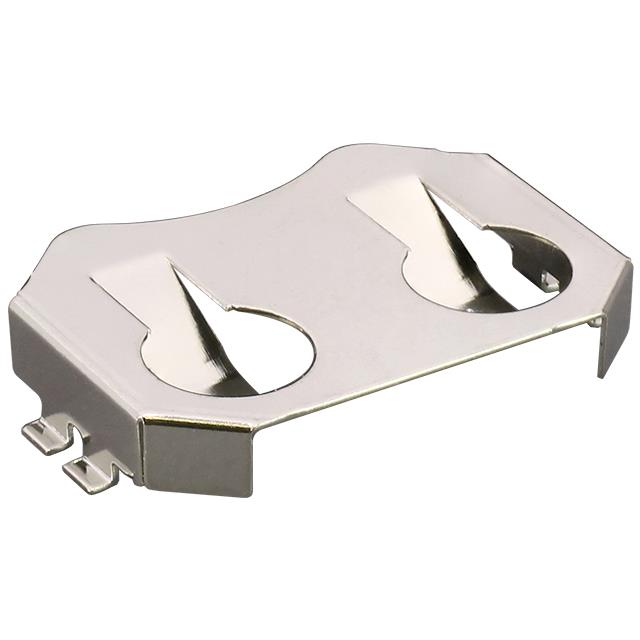STM32F103CBT6
STM32F103CBT6 is a 32-bit microcontroller based on the ARM Cortex-M3 core launched by STMicroelectronics, which belongs to the mainstream performance line of the STM32F1 series.
NCP5623CMUTBG
NCP5623CMUTBG is a three-channel current controller designed for RGB LED driving launched by ON Semiconductor.
Wiznet W5500
W5500 is a hardware-based TCP/IP protocol stack Ethernet controller developed by Wiznet.By communicating with the main control MCU through the SPI interface, W5500 can quickly implement network functions without implementing complex protocol stacks in the main control chip.
Microchip Technology ATMEGA128A-AU
ATmega128A-AU is an 8-bit microcontroller based on AVR architecture produced by Microchip Technology. It is widely used in embedded systems and is popular for its high performance and low power consumption.
Microchip Technology ATMEGA328P-AU
ATMEGA328P-AU is a cost-effective 8-bit microcontroller. Its rich resources, low-power design and good compatibility make it a widely used solution in embedded development, especially for embedded applications that require low power consumption and medium complexity.
Nordic Semiconductor NRF52832-QFAA-R
NRF52832-QFAA-R is a wireless communication chip with excellent performance, low power consumption and easy development. It supports the new features of Bluetooth 5.0, making it widely used in the fields of IoT, smart homes and portable devices. Its powerful computing power and multi-protocol support provide developers with flexible solutions.
ATMEGA328P-PU
ATmega328P-PU is an 8-bit microcontroller manufactured by Microchip Technology (formerly Atmel), widely used in embedded systems and development boards, especially popular on the Arduino platform.
STMicroelectronics LIS3DHTR
STMicroelectronics LIS3DHTR is a low-power, high-performance 3-axis digital accelerometer that is widely used in motion sensing, tilt detection, vibration monitoring and direction tracking. The sensor has a small size, high resolution and low power consumption, making it ideal for battery-powered devices and portable applications.
STMicroelectronics STM32F103VET6
STM32F103VET6 is a 32-bit microcontroller based on the ARM Cortex-M3 core produced by STMicroelectronics. It belongs to the high-performance product line of the STM32F1 series and is widely used in embedded applications such as industrial control, IoT devices, and home appliance control.
STMicroelectronics STM32F407ZET6
STM32F407ZET6 is a high-performance microcontroller produced by STMicroelectronics, which is widely used in industrial automation, Internet of Things, robot control and other fields.
STMicroelectronics STM32F105VCT6
STM32F105VCT6 is a versatile and powerful microcontroller that combines an ARM Cortex-M3 core with a rich set of peripherals and low power consumption. Its 128 KB Flash, 16 KB RAM, and extensive I/O options make it a suitable choice for a variety of embedded applications in industrial, automotive, and consumer markets. Its robust features, such as USB, CAN, ADC, and DMA, along with low-power operation, make it a solid solution for systems requiring real-time processing and efficient power usage.
Texas Instruments ULN2003ADR
ULN2003ADR is a common high current power driver produced by STMicroelectronics. It is a variant of the ULN2003 series and is usually used to control high current loads such as stepper motors, relays, solenoid valves, etc.
STM32F407VGT6 Microcontroller
TM32F407VGT6 is a powerful and flexible microcontroller suitable for a variety of embedded applications. Its high performance, rich peripheral interfaces and powerful processing capabilities make it an ideal choice for developing complex systems.
MCIMX6G2CVM05AB
MCIMX6G2CVM05AB is a powerful application processor that combines high-performance processing capabilities and rich multimedia functions, making it very suitable for a variety of embedded applications. Its low power consumption characteristics and flexible interface design enable it to perform well in various industrial and consumer applications.
STM32F405RGT6
The STM32F405RGT6 is a high-performance 32-bit microcontroller produced by STMicroelectronics. It is based on the ARM Cortex-M4 core and is suitable for embedded applications that require high performance and processing power.
ATMEGA328P-PU
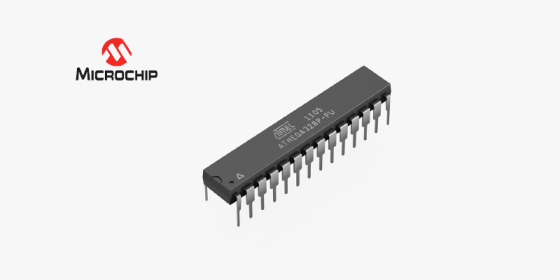
ATmega328P-PU microcontroller Introduction
ATmega328P-PU is an 8-bit microcontroller manufactured by Microchip Technology (formerly Atmel). It is widely used in embedded systems and development boards, especially on the Arduino platform. It is very popular and suitable for entry-level and intermediate developers.
ATmega328P-PU package
DIP-28: through-hole package, suitable for manual soldering
Also available in other package forms, such as TQFP and MLF
ATmega328P-PU development environment
Development platform: ATmega328P-PU is commonly used in Arduino development boards (such as Arduino Uno) and can be programmed in the Arduino IDE.
Programming language: Supports C and C++ programming languages
Bootloader: Built-in Bootloader simplifies the program upload process (via serial interface)
ATmega328P-PU application scenarios
Embedded system development
Arduino projects (such as sensor control, robotics, LED light control, etc.)
Home automation equipment
Portable electronic devices
ATmega328P-PU I/O Pins
Total number of pins: 28 (for DIP-28 package, PU is a through-hole package)
Digital input/output pins: 23, of which 6 support PWM output (in some configurations)
Analog input pins: 6, maximum input voltage is 5V, precision is 10 bits
Serial communication: 1 USART, for UART communication
SPI and I2C: support SPI and I2C communication
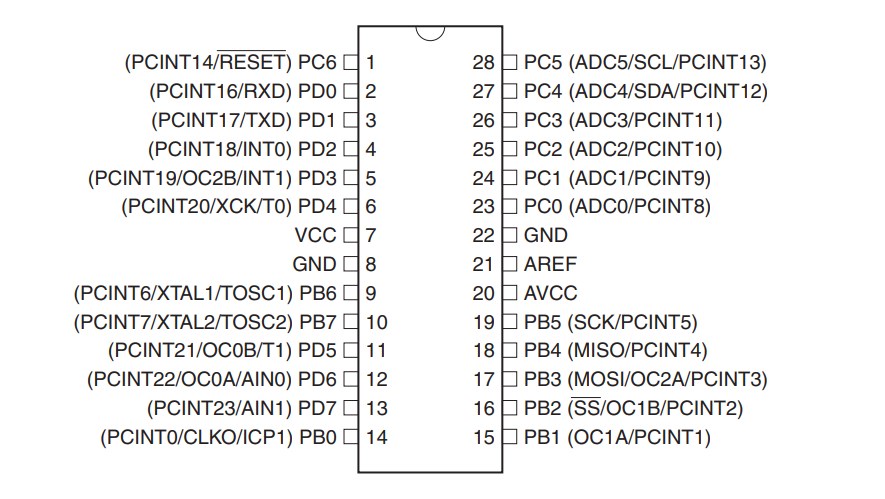
ATmega328P-PU Datasheet
LIS3DHTR Similar or Alternative
Product comparison
ATmega328P-PU vs ATmega48A-PU vs ATmega88PA-PU vs ATmega88A-PU Comparison
| Feature | ATmega328P-PU | ATmega48A-PU | ATmega88PA-PU | ATmega88A-PU |
|---|---|---|---|---|
| Image |  | 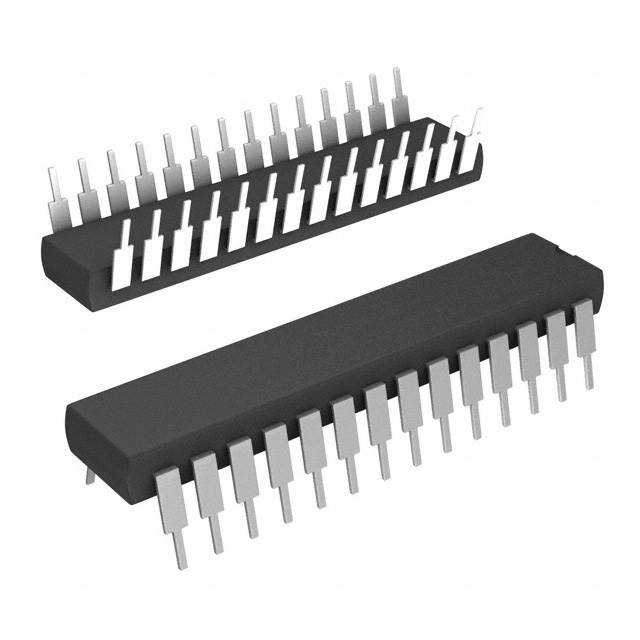 | 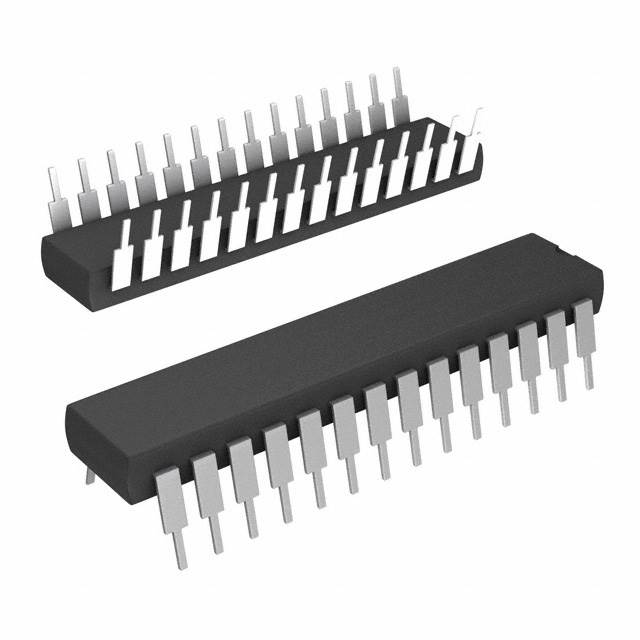 |  |
| Manufacturer | Microchip Technology | Microchip Technology | Microchip Technology | Microchip Technology |
| Core | AVR 8-bit | AVR 8-bit | AVR 8-bit | AVR 8-bit |
| Flash Memory | 32 KB | 4 KB | 8 KB | 8 KB |
| SRAM | 2 KB | 512 B | 1 KB | 1 KB |
| EEPROM | 1 KB | 256 B | 512 B | 512 B |
| Clock Speed | 20 MHz | 8 MHz | 20 MHz | 20 MHz |
| GPIO Pins | 23 (6 PWM, 6 Analog Inputs) | 23 (6 PWM, 6 Analog Inputs) | 23 (6 PWM, 8 Analog Inputs) | 23 (6 PWM, 8 Analog Inputs) |
| Package Options | DIP-28, TQFP-32, MLF-32 | DIP-28, TQFP-32, MLF-32 | DIP-28, TQFP-32, MLF-32 | DIP-28, TQFP-32, MLF-32 |
| Timer/Counter | 3 (2x 8-bit, 1x 16-bit) | 2 (1x 8-bit, 1x 16-bit) | (2x 8-bit, 1x 16-bit) | (2x 8-bit, 1x 16-bit) |
| USART | 1 (Serial) | 1 (Serial) | 1 (Serial) | 1 (Serial) |
| SPI | Yes | Yes | Yes | Yes |
| I2C (TWI) | Yes | Yes | Yes | Yes |
| External Interrupts | 2 | 2 | 2 | 2 |
| Operating Voltage | 1.8V to 5.5V | 1.8V to 5.5V | 1.8V to 5.5V | 1.8V to 5.5V |
| Internal Oscillator | 8 MHz (default) | 8 MHz (default) | 8 MHz (default) | 8 MHz (default) |
| Low Power Modes | Yes (Idle, Power-save, Standby) | Yes (Idle, Power-save, Standby) | Yes (Idle, Power-save, Standby) | Yes (Idle, Power-save, Standby) |
| ADC Channels | 6 (10-bit resolution) | 6 (10-bit resolution) | 8 (10-bit resolution) | 8 (10-bit resolution) |
| Temperature Range | -40°C to 85°C | -40°C to 85°C | -40°C to 85°C | -40°C to 85°C |
Main differences:
Memory size:
ATmega328P-PU has the largest flash memory (32 KB), making it more suitable for applications that require larger program memory.
ATmega48A-PU has the smallest flash memory (4 KB), which is more suitable for simple applications with limited program size.
The ATmega88PA-PU and ATmega88A-PU offer a balanced 8 KB of flash and 1 KB of SRAM, which is slightly better than the ATmega48A-PU for more complex tasks.
SRAM:
The ATmega328P-PU has 2 KB of SRAM, the highest of all models.
The ATmega48A-PU has only 512 B of SRAM, which may limit the complexity of data processing in the application.
Analog Inputs:
The ATmega328P-PU has 6 analog input channels, while the ATmega88PA-PU and ATmega88A-PU have 8 analog inputs, making them more suitable for projects with multiple analog sensors.
Package and Features:
All variants offer similar package options (DIP-28, TQFP-32, MLF-32) and support standard peripheral features such as SPI, I2C, and UART, but the ATmega88PA-PU and ATmega88A-PU have slightly more analog input pins.
Conclusion:
The ATmega328P-PU is a good fit for general-purpose applications that require higher flash, SRAM, and peripheral support.
The ATmega48A-PU is better suited for very simple, cost-sensitive designs.
The ATmega88PA-PU and ATmega88A-PU are good middle-of-the-road options, offering more analog inputs and slightly more memory than the ATmega48A-PU, with similar features to the ATmega328P-PU, but at a lower cost.
If you develop with Arduino, the ATmega328P-PU is the most commonly used. Other variants are more niche, but may fit the memory and peripheral requirements of your project.
ATmega328P-PU FAQs
1. What is the difference between the ATmega328P-PU and the ATmega328P?
ATmega328P-PU refers to the PDIP (Plastic Dual In-line Package) version of the ATmega328P microcontroller, which is suitable for breadboarding and through-hole soldering. The ATmega328P is also available in other package types, such as TQFP (Thin Quad Flat Package) and MLF (Micro Lead Frame), which are suitable for surface mount applications.
2. What programming languages can I use to program the ATmega328P-PU?
The ATmega328P-PU is usually programmed using the C and C++ languages. The Arduino IDE also supports this microcontroller, allowing you to use the Arduino language, which is a simplified subset of C++.
3. What is the clock speed of the ATmega328P-PU?
The ATmega328P-PU typically runs at 16 MHz using an external crystal oscillator, or 8 MHz if the internal clock is used.
4. What is the maximum operating voltage of the ATmega328P-PU?
The operating voltage range of the ATmega328P-PU is 1.8V to 5.5V, but 5V is typically used in most applications.
5. How do I program the ATmega328P-PU?
You can program the ATmega328P-PU using a USB to serial adapter such as the FTDI adapter, or you can upload code to the microcontroller using a dedicated ISP (In-System Programming) tool such as AVRISP, USBasp, or Arduino as ISP.
6. Can I use the ATmega328P-PU with an Arduino?
Yes, the ATmega328P-PU is commonly used with Arduino boards, especially the Arduino Uno. The chip comes pre-installed with the Arduino bootloader, which makes it very easy to upload code through the serial interface.
7. Does the ATmega328P-PU have a built-in analog-to-digital conversion (ADC)?
Yes, the ATmega328P-PU has a 10-bit ADC and 6 analog input pins that allow you to convert analog signals into digital values for processing.
8. What is the power consumption of the ATmega328P-PU?
The power consumption of the ATmega328P-PU depends on the clock speed and the operating voltage. In normal mode at 5V, it typically consumes about 8-10 mA at 16 MHz. In sleep mode (such as idle or power saving), the current consumption drops to 0.1 mA.
9. How to connect the ATmega328P-PU with sensors or other devices?
The ATmega328P-PU can interface with sensors or devices using digital signals (high/low) or analog signals (using ADC) through its I/O pins. You can also use communication protocols such as I2C, SPI, and UART to implement more advanced sensor interfaces.
10. What are the limitations of the ATmega328P-PU?
While the ATmega328P-PU is a versatile microcontroller, it does have some limitations:
Limited RAM (2 KB), which may limit memory-intensive applications.
Limited number of I/O pins (23), which may not be enough for projects that connect many devices.
Flash memory (32 KB) may not be enough for large applications, especially those with a lot of code or libraries.
There is no hardware floating point unit (FPU), so floating point operations may be slower than more advanced microcontrollers.
11. Can I overclock the ATmega328P-PU to 20 MHz?
While the ATmega328P-PU can theoretically run up to 20 MHz, it is usually used with a 16 MHz clock for reliable operation. Overclocking may cause instability or exceed the rated specifications of the chip, so it is not recommended unless you are using it in a specific design where reliability is not important.
12. Can the ATmega328P-PU be used in battery-powered applications?
Yes, the ATmega328P-PU can be used in low-power applications, especially when running in sleep mode or using a low-frequency crystal to perform time-sensitive tasks. It is often used in battery-powered devices such as remote sensors and portable electronics.


